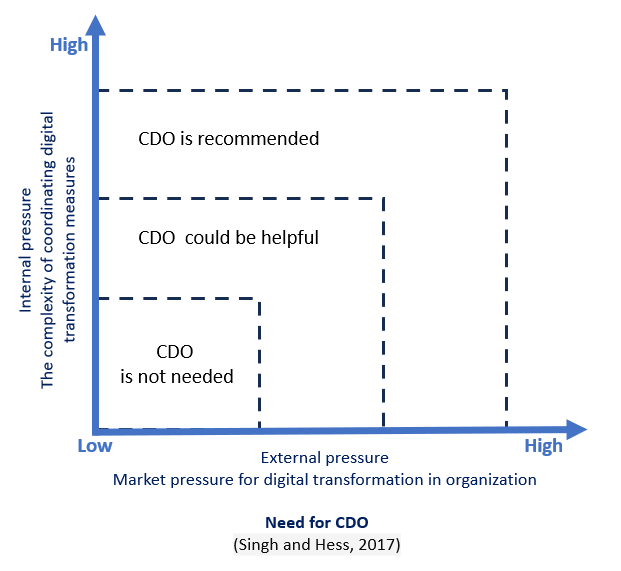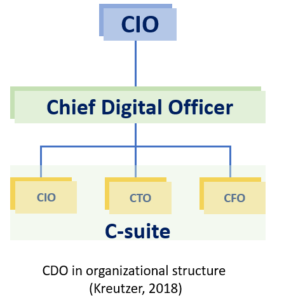Currently Empty: € 0,00

Digital involves designing and utilizing organizational structures essential for developing and interpreting resources for digital transformation (Bonnet and Westerman, 2014). These mechanisms aim to advance the digital organization. One approach to digital transformation is appointing a Chief Digital Officer (CDO) to lead these efforts. Although there is no universal definition for the role (Haffke et al., 2016), a CDO generally acts as a business strategist aware of digital technologies’ organizational impacts, responsible for driving transformation through these technologies. The CDO role is currently the fastest-growing senior management position, predominantly in US companies (Horlacher & Hess, 2016).
According to Barclays’ Chief Digital Officer, CIOs are tasked with transforming how a business perceives the organization from a customer’s perspective (Doonan, 2017). This involves fostering a culture focused on customer needs, rather than designing specific systems.
The CDO is often the highest position for overseeing digital transformation within an organization (Kreutzer, 2018), with key responsibilities including creating a digital business model, providing digital innovations, and promoting organizational integration. However, the CDO role varies by organization, requiring tailored actions based on specific circumstances.
Importance and Necessity of Appointing a Chief Digital Officer
For many organizations, appointing a CDO marks the beginning of their digital transformation. This appointment signals impending changes (Singh and Hess, 2017). Not all companies need a separate CDO position; in some cases, these responsibilities can be managed by other senior managers, such as IT, marketing, or strategy managers. However, for larger organizations with a serious commitment to transformation, a dedicated CDO is essential.
The necessity of a CDO is evaluated based on two factors (Singh and Hess, 2017):
- The external demand for digital transformation.
- The complexity of internal mechanisms for digital transformation.
A CDO is valuable only if the organization is strongly committed to digital transformation, including the associated costs (Singh and Hess, 2017). Prior to appointing a CDO, it’s crucial to ensure organizational alignment and integrity, as this role will alter the command structure at the start of the digital journey. Figure 1 illustrates the need for a CDO based on organizational structure.


Chief Digital Officer Competencies
The concept of competence, introduced by David McClelland in his 1973 article “Measuring Competence Instead of Intelligence,” challenges the effectiveness of traditional IQ tests and educational qualifications as predictors of job performance. McClelland proposed that competencies, deeper characteristics enabling individuals to excel in their roles, are better indicators of job success.
As a senior executive, a Chief Digital Officer (CDO) shares many competencies with other top managers. However, CDO-specific competencies can be classified into four categories:
Personal Characteristics: Certain managerial traits are innate and enable a CDO to significantly impact organizational transformation. These traits include a charismatic personality, dynamism, agile thinking, result orientation, humility, openness, digital transformation experience, honesty, opportunism, extroversion, and reliability.
Professional Skills: Professional skills, which can be developed and refined, are essential for CDOs to perform effectively. These include leadership, effective communication, storytelling, systems thinking, active listening, persuasion, foresight, risk-taking, continuous learning, process orientation, strategic thinking, and critical thinking.
Business Knowledge: A CDO must have a comprehensive understanding of the organization’s business operations. This includes mastery of business processes and models, in-depth industry knowledge, understanding organizational culture, detailed knowledge of products and services, entrepreneurial thinking, financial acumen, public relations, business development, and digital marketing concepts.
Technical Knowledge: Technical expertise is crucial for a CDO. This includes knowledge of emerging and digital technologies, software development (especially agile methodologies), computer networks, project management, programming basics (e.g., object orientation), and experience design principles.
Chief Digital Officer Responsibilities
To achieve digital transformation, a CDO’s responsibilities vary based on organizational characteristics such as size, culture, and industry. Generally, CDO duties include:
Planning and Directing: A CDO must establish and lead the digital transformation strategy. This includes planning the digital journey, managing digital transformation projects, and driving innovation in products, services, and business models.
Coordinating and Modernizing Digital Transformation Efforts: A CDO collaborates with senior managers and stakeholders to implement digital transformation initiatives across the organization. This includes identifying and solving problems digitally, fostering empathy and collaboration at all organizational levels, and ensuring stakeholder alignment.
Environmental Monitoring and Networking: Externally, a CDO identifies opportunities, partners, and competitors to enhance the business. This involves attending events, networking, and staying abreast of emerging trends in digital transformation to improve organizational performance.
References
- Westerman, G., Bonnet, D., & McAfee, A. (2014). Leading digital: Turning technology into business transformation. Harvard Business Press.
- Haffke, I., Kalgovas, B. J., & Benlian, A. (2016). The Role of the CIO and the CDO in an Organization’s Digital Transformation.
- Horlacher, A., & Hess, T. (2016). What does a Chief Digital Officer do? Managerial tasks and roles of a new C-level position in the context of digital transformation. In 2016 49th Hawaii International Conference on System Sciences (HICSS) (pp. 5126-5135). IEEE.
- Doonan, M. (2018). So you’ve just hired a killer chief digital officer–now what?. Strategic HR Review, 17(1), 17-22.
- Singh, A., & Hess, T. (2017). How Chief Digital Officers Promote the Digital Transformation of their Companies. MIS Quarterly Executive, 16(1).
- Kreutzer, R. T., Neugebauer, T., Pattloch, A., Kreutzer, R. T., Neugebauer, T., & Pattloch, A. (2018). Eight Areas of Action to Build a Digital Business Leadership. Digital Business Leadership: Digital Transformation, Business Model Innovation, Agile Organization, Change Management, 43-196.
